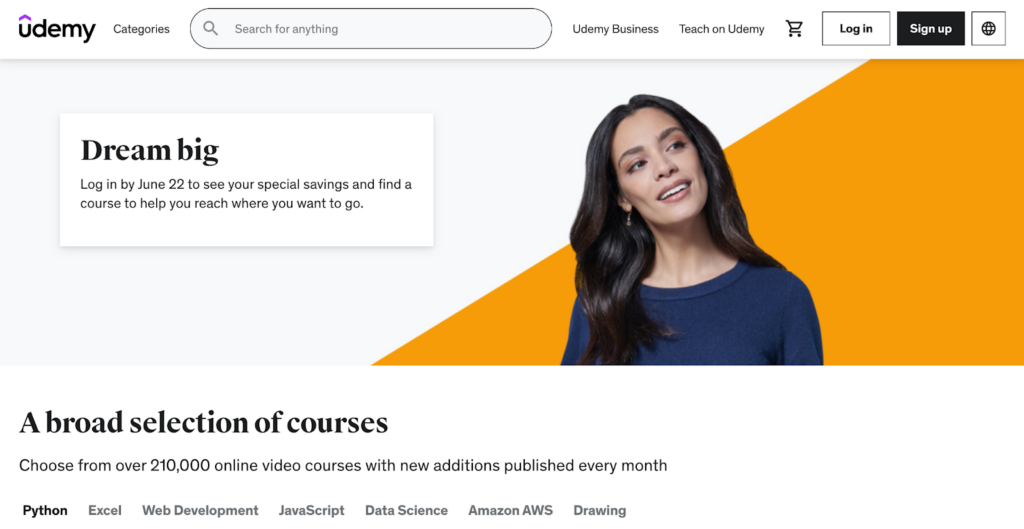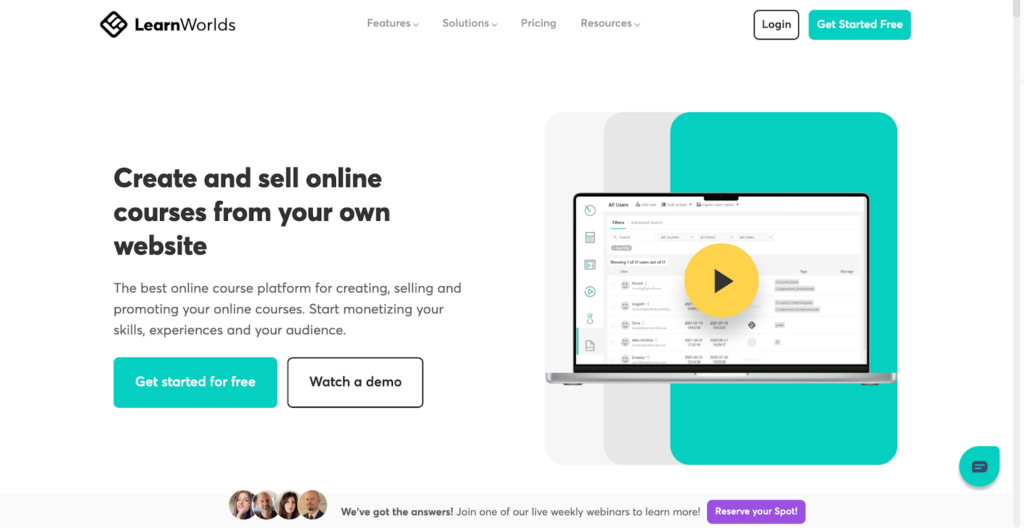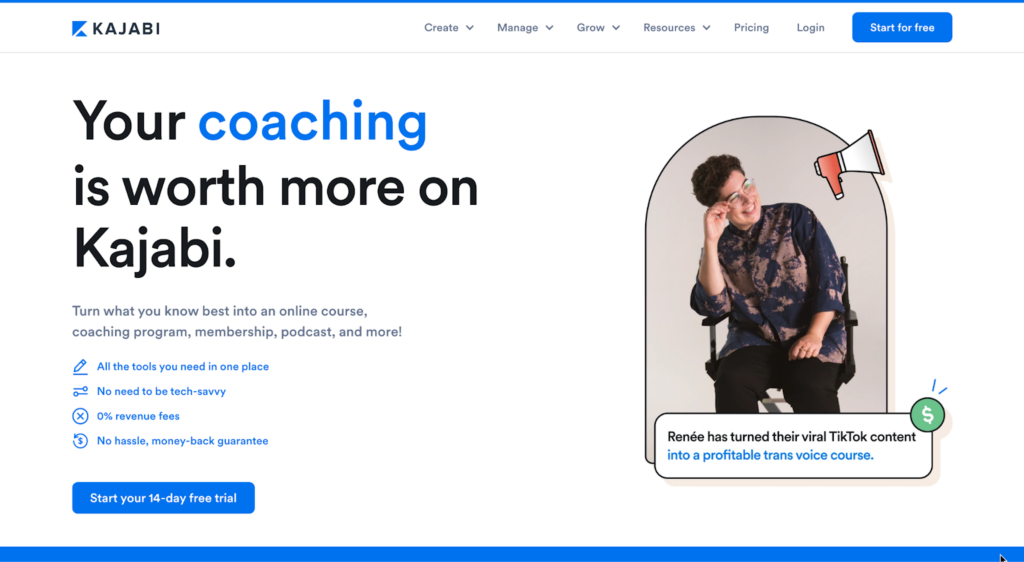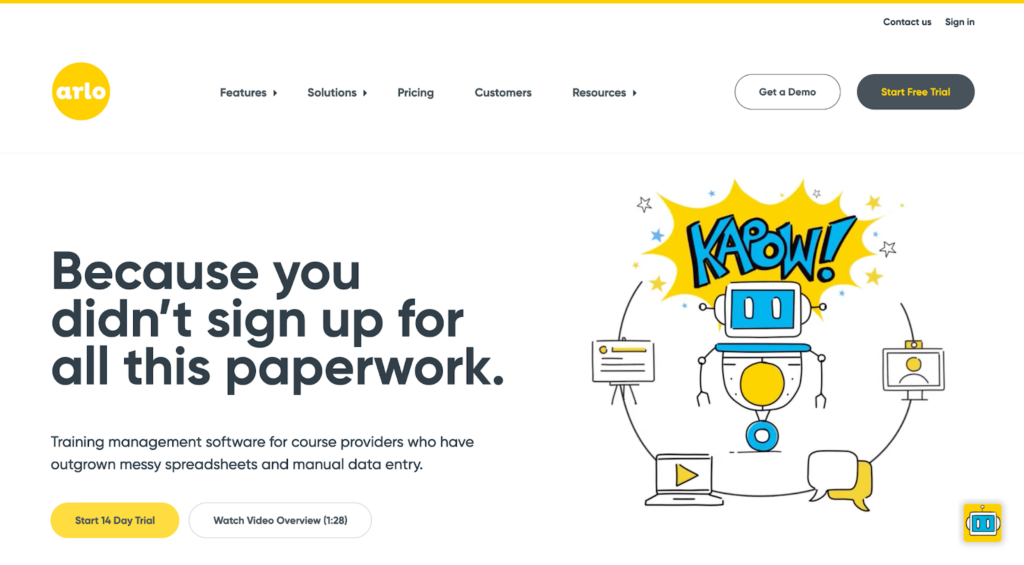Online learning is a rapidly growing business. By 2025, the global e-learning market is projected to reach $350 billion—and 90% of companies already offer their employees some form of online learning.
So if you’ve been thinking about creating and selling a course online to grow your business—now is the time to do it. The first thing you’ll need is all the knowledge and experience you will share. The second thing? You’ve got to choose the best online teaching platform to build your course on.
In this article, we’ll compare all the best online teaching platforms to earn money, so you can pick one that suits you and start making money in no time.
Click the links below to skip ahead:
- What are online teaching platforms?
- How are online learning and online teaching platforms different?
- 11 best free online teaching platforms in 2024
- Monetize your content with a custom online course
What are online teaching platforms?
Online teaching platforms provide the tools you need to create a complete learning experience on the web. Those tools and approaches can be very different:
- Some are standalone platforms; others integrate into your website
- Some allow you to create self-paced courses; others focus on live teaching
- Some are free; others require a monthly subscription
- Some have drag-and-drop editors; others require custom coding
There are a lot of features to consider when picking the best platform for online teaching. But first, let’s clarify the difference between online teaching and online learning platforms.
Related: 10 Steps To Creating A Wildly Successful Online Course
How are online learning and online teaching platforms different?
While online learning and online teaching platforms can often be the two sides of the same coin, that’s not always the case.
Online learning platforms (also known as online course marketplaces) are often centralized to provide a wide selection of courses that users can choose from. Sometimes these courses are created by individual contributors, but other platforms can choose to commission custom courses (e.g., Treehouse or Lynda) or use courses offered by higher education institutions (e.g., edX).
Online teaching platforms, on the other hand, provide all the necessary tools—from payment processors to email marketing—to enable anyone to create and sell an online course. Both individuals and companies often use the best online teaching platforms for corporate training, onboarding, and customer success.
So how do you choose the best online teaching platform for your online course business?
11 best free online teaching platforms in 2024
Online teaching platforms are ideal for course creators, allowing you to choose when and how you want to work—and reach as many students as you wish. You can create your course once and sell it thousands of times. You can also start with one course and eventually expand to a whole academy. In other words, there are virtually no limits on what you can accomplish.
Some online teaching platforms offer additional community-building features, including forums, memberships, Q&A sessions, chats, and more. In some cases, you don’t even need a website—you can build an online store, a course, and a community all in one place, with web hosting and free themes covered as well.
Here are the best online teaching platforms to choose from. Click the links to skip ahead.
| 1. Thinkific | Pros:
Cons:
|
| 2. The Leap | Pros:
Cons:
|
| 3. Udemy | Pros:
Cons:
|
| 4. Skillshare | Pros:
Cons:
|
| 5. Teachable | Pros:
Cons:
|
| 6. Podia | Pros:
Cons:
|
| 7. LearnWorlds | Pros:
Cons:
|
| 8. Kajabi | Pros:
Cons:
|
| 9. WizIQ | Pros:
Cons:
|
| 10. EdApp | Pros:
Cons:
|
| 11. Arlo | Pros:
Cons:
|
| 12. LearnDash | Pros:
Cons:
|
1. Thinkific
Earning the title of the best platform for online teaching, Thinkific is an all-in-one scalable solution for course creation, community-building, and membership monetization. One of the most well-rounded course creation platforms around, Thinkific takes care of your teaching business from A to Z.
Get started with a free plan to create a beautiful website, engage your audience with communities, and sell courses the way you want, from subscriptions to one-time payments. With a simple drag-and-drop course builder, you can have your first course up and running in less than a day.
Thinkific’s best-in-class customer support is also there to help you every step of the way, whether you’re a first-time creator or an enterprise business. You can also join the Thinkific Studio, an expert creator community, to learn from people who have been-there done-that and are ready to give you all the support you need.
Looking to drive additional revenue? With add on features, like Branded Mobile, you can unlock additional revenue streams for your business, while spotlighting your brand with your own white-labeled mobile app.
Looking for some extra features? Get access to a whole range of third-party app integrations in the Thinkific App Store. These help you level up your course business and start earning more money from your expertise.
Both will help you level up your course business and start earning more money from your expertise.
Pros:
- Free plan available
- Intuitive drag-and-drop website builder
- Powerful marketing tools and integrations
- Extensive 3rd party App Store
- 24/7 support
- Drive additional revenue and offer your content through your own white-labeled mobile app
Cons:
- Limited choices for website designs
- Need to market off the platform to find students
2. The Leap

Standing out in the online teaching domain, The Leap offers creators a unique approach to course creation. The Leap’s focus on mini-courses and functionality as a link-in-bio storefront for digital products makes it a top contender in the online teaching space.
3.Udemy
One of the largest online teaching platforms with more than 40 million students, Udemy’s mission is to make high-quality education accessible to people worldwide.
But unlike some of Udemy’s alternatives, not everyone can create a monetized course on the platform—it’s a curated process. If you want to charge for your course, you’ll have to get approved by the platform first. Your course also has to feature at least five video lectures and be 30 minutes long or more.
Fortunately, Udemy offers a lot of guidance for first-time course creators building their online courses, from advice on video equipment to feedback on the actual content. You also have the chance to be featured in Udemy’s marketing materials, which can bring your courses to a wider audience. To track your progress, the online teaching platform offers comprehensive analytics so you can assess how your course is performing compared to others on the platform.
Pros:
- Millions of students are already on the platform
- Good marketing support
- Built-in analytics and insights
Cons:
- Have to get approved before creating courses
- Requirements on length and type of course
- Up to 63% revenue share on courses sold by Udemy + transaction fees
4. Skillshare
If you’re thinking of creating a course for creatives, designers, photographers, or entrepreneurs, you’ll probably find your target audience on the online course marketplace, Skillshare.
Skillshare has over 35,000 paid courses on topics from marketing to illustration to productivity. Anyone can sign up and create a free course, but your course has to be in Skillshare’s premium catalog to get paid for your content.
Unlike other platforms, Skillshare focuses on bite-sized lessons (around five minutes each), and classes rarely exceed two hours—the platform preferences practical knowledge that can be implemented immediately and is supported by community discussions.
Skillshare also differs from other platforms by charging students a monthly subscription fee—this unlocks all premium course content. This fee is then allocated to creators based on the number of minutes watched.
Pros:
- Easy to start
- An engaged specialist community
- Tailored to creatives
Cons:
- Have to be approved for a premium course to monetize
- No control over pricing
- Limited offering besides courses
5. Teachable
If you’re an experienced creator who already knows what it takes to build a successful course, you might consider Teachable as your next online teaching platform.
Earning fourth in this list of the best online teaching platforms to earn money, Teachable gives creators a wide range of customization features. These help you bring the look and feel of your course as close to your brand as possible. You don’t have to know how to code to create your first course, but keen coders can use the Power Editor to make custom changes.
Since Teachable lets you create courses independent of any platform, you can charge for them any way you like: as a single price, a payment plan, or a subscription. One of the most powerful Teachable features is its marketing tools. Use them to collect feedback, email a segment of your audience, notify students about upcoming courses, and more.
Pros:
- Powerful toolkit for experienced course creators
- Effective in-built marketing tools
- Customizable pricing options
Cons:
- High 10% transaction fee on a free plan
- No audience exposure except your own
- Better suited to experienced course creators
6. Podia
Whether you’re looking to create and sell courses or find e-commerce solutions that cover every aspect of being a digital store owner, Podia has a range of tools available to help you build the business you want.
Podia is designed to be the profit center for all your content, from courses to downloads to webinars and everything in between. Podia offers easy-to-use templates for all creators and makes selling a range of digital products in your online store straightforward.
Creating a course on Podia is simple too. You have the option to publish your content right away or create a pre-launch campaign. Any other digital products you’ve produced can also be sold alongside your course as bundles.
Start your own brand community with a membership section on the platform and create premium content offerings for your paying subscribers to take your business up a notch.
Pros:
- Sell all digital products at once
- Community-building tools
- Flexible pricing options
Cons:
- Lacks custom design tools
- Course-creation features are less powerful than competitors
- 8% transaction fee on free plans
7. LearnWorlds
If you’re looking to build a new digital school from scratch, LearnWorlds is a powerful tool to help you do just that. LearnWorlds brings together a range of features to help you quickly create multiple courses and manage multiple instructors on the same platform.
Every new school on LearnWorlds has its own space to build a digital community and encourage student interaction. The platform also offers different permission levels, so your instructors can teach and start community discussions but can’t modify your courses, for example. Each student also has an individual profile where they can showcase their learning progress.
To help you prioritize mobile learning, LearnWorlds also offers tools for building your own branded iOS and Android app (for an extra fee), with in-app purchases and custom push notifications too.
Pros:
- Great for small businesses
- Management features for admins and instructors
- Option to build a branded mobile app
Cons:
- $5 transaction fees on a paid plan
- No physical inventory management for non-digital products
- No option for live courses on the basic plan
8. Kajabi
Like other combined eCommerce and online teaching platforms, Kajabi helps you create, grow and manage all kinds of digital products from courses to podcasts to communities and more.
What makes Kajabi stand out is how fast it is to create a new business using the platform, thanks to its range of powerful templates. Build a whole marketing funnel from a landing page to sales emails and everything in between using Kajabi’s uncomplicated building tools. Then monitor your marketing strategy using built-in analytics to see what works and what needs adjusting.
Pros:
- Fast and easy set-up
- Intuitive UX and product management
- Email-to-purchase analytics
Cons:
- No free plan, only a 14-day trial
- Paid plans start at $119/month when billed annually
- Limited customer support
9. WizIQ
If you want to create a real-time online learning experience, WizIQ might be your online teaching platform. WizIQ is a complete education platform for live and self-paced courses. You can create and sell your classes right on the platform with their easy-to-use tools.
WizIQ caters to a wide range of education businesses. Teachers use WizIQ to offer tutoring services, software companies train their customers and partners, and even higher education institutions use WizIQ to deliver online courses. With the all-in-one platform, you can create courses and assessments, design your own virtual classroom, and keep track of everything with a comprehensive analytics dashboard.
Pros:
- Customizable virtual classrooms
- ECommerce tools for selling courses
- eLearning mobile app available
Cons:
- Best for live courses only
- Limited customer support
- Less intuitive than other platforms
10. EdApp
For organizations, the best online teaching platforms are ones with intuitive tools for building employee education programs at scale. EdApp lets you deliver the training experience your team needs with a range of features designed to help you educate learners fast.
Among its top features, EdApp offers companies the chance to white-label their own courses for training and onboarding employees, partners, and customers. In addition, EdApp features over 80 templates for quick custom course creation with options to add games, quizzes, videos, assessments, and more. Plus, all learning can be delivered right to your employees’ mobile devices for training on the go.
Pros:
- Free plan available
- 80+ ready-made course templates
- White-labeling options
Cons:
- Pricing calculated per user per month
- Best suited to bigger organizations
- Limited monetization options
11. Arlo
Arlo is an online teaching platform designed for growing businesses. Their training management software is tailor-made to give companies full control over how they deliver training, onboarding, and essential courses to employees. With Arlo, you can schedule courses, assign instructors, generate automated certificates, and much more. Choose to host courses in-person or online, depending on where your workforce is.
Note: If you’re looking to build an online course from scratch, Arlo probably isn’t the platform for you. It doesn’t have robust features for course creation—it’s a management tool that’s built for training rather than a course-builder for content creators.
Pros:
- Everything you need to manage corporate training
- Schedule in-person and online courses
- Assign instructors and admins
Cons:
- Not suitable for first-time course creators
- No course-building interface
- Not meant for external audiences
12. LearnDash
Already have a WordPress website? Take a look at LearnDash for online teaching. Rounding out this list of the best online teaching platforms to earn money, LearnDash is a powerful WordPress plugin that adds course-selling functionality right to your website.
With a range of course-creation tools, LearnDash offers an easy drag-and-drop interface to help you build your first online course in minutes. Add quizzes, certificates, and grades to your online course, and customize the design to match your branding. LearnDash is simple and fast—ideal for first-timers.
Pros:
- Build your first course on your website
- Works with any WordPress theme
- Easy to get started
Cons:
- No live course features
- Only available on WordPress
- Limited community-building tools
Monetize your content with a custom online course
Build your flagship course, community, or membership site on Thinkific today.
Or want to build your own mini-course, quickly and easily? Try out The Leap for free today.
This blog was originally published in June 2022. It has since been updated on October 12, 2023 to include even more options.


















